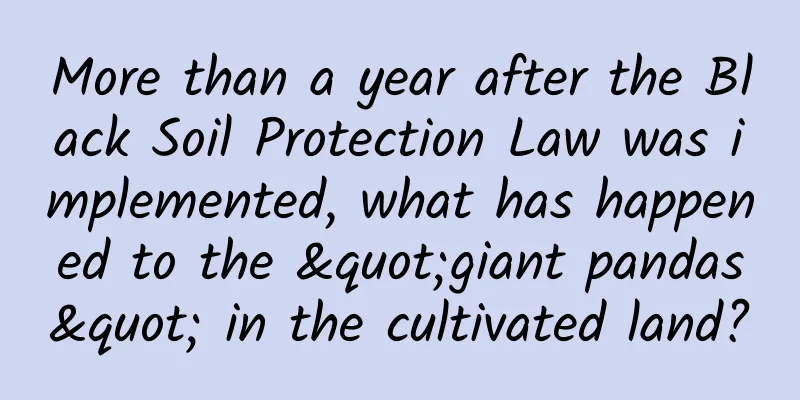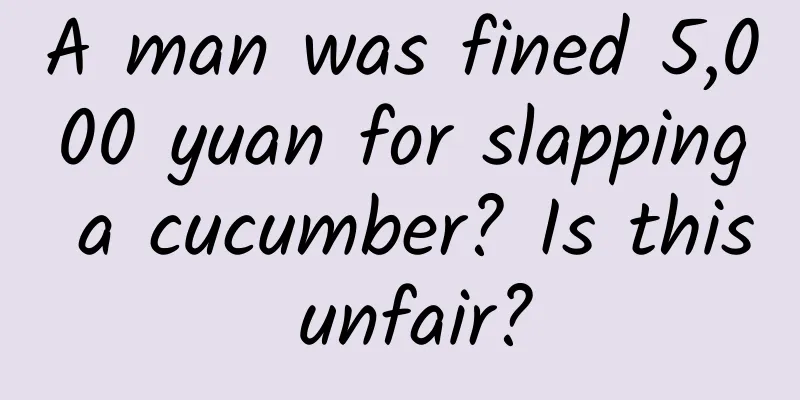More than a year after the Black Soil Protection Law was implemented, what has happened to the "giant pandas" in the cultivated land?

|
Written by reporter Chen Yongjie Photo and text editor Chen Yongjie Image source/Visual China Audit experts: Li Baoguo (Dean and Professor of College of Land Science and Technology, China Agricultural University) The high-yield black soil is known as the "giant panda among cultivated land". General Secretary Xi Jinping stressed: "We must take the protection of black soil as a major issue and use and protect the black soil well." "We must strengthen the empowerment of digital technology and biotechnology, give priority to turning black soil into high-standard farmland, and effectively protect the black soil." Fertile black soil is a rare soil resource on Earth. According to the latest statistics, there are about 294 million mu of typical black soil arable land in Northeast my country, accounting for 15.4% of the country's arable land area. The "Black Soil Protection Law of the People's Republic of China", which came into effect on August 1, 2022, constructs legal systems and measures based on the characteristics of protecting black soil, which is of far-reaching significance for ensuring national ecological security and food security. ▲A land preparation machine is repairing the black soil at Heilongjiang Shuangyashan Friendship Farm. In the more than one year since the Black Soil Protection Law was implemented, all regions and departments have taken effective measures to maintain quantity and improve quality, effectively protecting the excellent production capacity of black soil, ensuring national food security, and maintaining the balance of the ecosystem. By 2023, the area of conservation tillage implemented in Heilongjiang, Jilin, Liaoning and Inner Mongolia has exceeded 90 million mu. During the 14th Five-Year Plan period, my country will complete the task of protecting and utilizing 100 million mu of black soil. The quality of black soil arable land will be significantly improved, and the soil organic matter content is expected to increase by an average of more than 10%. According to monitoring, the quality of arable land in the black soil area of Liaoning Province has been greatly improved. The quality of arable land in the project area has increased by an average of more than 0.5 grades, and the average content of soil organic matter has increased by more than 3 percentage points. The average grade of arable land quality in Heilongjiang Province has reached 3.46, and the average content of soil organic matter has reached 36.2 grams/kilogram. The Origin of the "Giant Panda" in Cultivated Land Why is black soil called the "giant panda" among cultivated land? When we talk about giant pandas, we tend to think of their preciousness and rarity, and even their fragility. There are only four major black soil areas in the world: the Ukrainian Plains with an area of about 1.9 million square kilometers; the Mississippi Plains in the United States with an area of about 1.2 million square kilometers; China's Northeast Plains with an area of about 1.03 million square kilometers; and the Pampas in South America, which stretches from Argentina to Uruguay with an area of 760,000 square kilometers. In my country, black soil can only be developed under the unique bioclimatic conditions of the Northeast. The formation of black soil takes a long time, and it takes about 200 to 600 years to develop a 1 cm black soil layer. ▲Schematic diagram of the formation of black soil Black soil is not only a good source of corn, soybeans, rice and other crops, but also of high quality. However, the black soil, which used to produce oil when you pinched it and sprouted a chopstick, has long been overused and neglected, and is now facing problems such as soil erosion, thinning of the soil layer and reduced fertility. If we do not take effective protective measures, we may lose this "beautiful black" in the near future. The primary problem facing black soil is serious degradation. After being reclaimed, black soil has actually become fragile. For example, black soil that has been reclaimed for about 100 years is rapidly thinning. The black soil layer has changed from about 50 cm to 1 meter to about 15 cm to 50 cm, and the black soil layer can be consumed by about 2 mm per year on average. The black soil layer is becoming thinner and thinner, which means that the organic matter in the black soil is decreasing. The color of the black soil has changed from black to yellow, or even light black, and the color is getting lighter and lighter. The reason for the lighter color is that the organic matter content of the soil is gradually decreasing, and the further you go to the south of the three northeastern provinces, the more serious the decline of organic matter in the black soil. As the black soil layer becomes thinner and thinner, the structure of the black soil also begins to deteriorate. The most obvious situation is that the black soil becomes hard. In the entire Northeast region, the arable land area of black soil is about 538 million mu, and the relatively thick black soil layer accounts for about 50%. All the arable land areas together account for 27% of the country. Their total grain output accounts for 1/4 of the country, and most importantly, the amount of grain transferred out accounts for 1/3 of the country. The black soil in Northeast China is the "backbone" of our food security, and it is truly worthy of describing it as the "giant panda" among cultivated land. Soil Science Principles of Conservation Tillage How can we protect the black soil and the "giant panda" among cultivated land? This requires understanding the general principles of soil science. In 2017, the Food and Agriculture Organization of the United Nations (FAO) proposed ten principles for sustainable soil management. These ten principles are also the most important principles or principles for how to protect soil quality and enable sustainable agricultural production and planting in our land use management and agricultural sustainable development. ▲In 2017, the Food and Agriculture Organization of the United Nations (FAO) proposed ten principles for sustainable soil management The first is to do everything possible to reduce soil erosion. The second is to increase the content of soil organic matter. The third is to balance the nutrients in the soil and to have a good cycle. The last one is to improve the management of soil moisture. Water is the source of life, and the amount of water supply actually determines the yield of crops. The solution proposed by the international community is protective utilization, or conservation agriculture. What does conservation agriculture protect? In fact, it is to protect the most basic soil resources in agricultural development. Only when the soil resources are well protected can they be used sustainably and agricultural production can be used sustainably. In conservation agriculture, there are actually three parts: no-tillage, mulching and crop rotation. This is our conservation agriculture farming system. No-till means avoiding plowing the land as much as possible, and covering means that the surface should be covered with vegetation, whether it is the coverage of the crops themselves during the growing period or the crop stubble or residues after harvest. On the basis of no-tillage and mulching, crop rotation can be added. For example, in the Northeast region, corn and soybean can be rotated, and where conditions permit, water-land rotation can be used. This means that the same crop cannot be planted on a piece of land forever. ▲The Food and Agriculture Organization of the United Nations (FAO) proposed the principles of conservation agriculture: no-tillage, mulching, and crop rotation Traditional farming requires plowing and leveling the land before sowing. It requires a variety of machines to enter the field and move the soil to ensure good growth conditions for the plants. We should encourage the transformation of traditional farming to no-till or less-till. Less-till means that the soil should not be turned or moved as much as possible, that is, only the sowing belt should be sown after strip tillage, and deep tillage should be carried out if necessary. No-till means that sowing and fertilization are completed at one time under the condition of straw covering. No-till means that the no-till seeder is used to apply fertilizer and insecticide at the same time as sowing. Internationally, more and more countries are adopting conservation tillage, especially in America. The areas involved in North and South America are increasing, and 80 to 90 percent of the land is under conservation tillage. No-tillage, sowing and straw mulching are based on the original ecosystem of the soil as much as possible, which can dramatically increase the "vitality" of the organisms in the soil, especially the "engineers" of soil tillage - earthworms. After no-tillage, the task of improving soil structure is actually handed over to organisms. ▲Earthworms are the "engineers" of soil tillage. The task of improving soil structure is actually given to organisms. Studies have shown that, whether it is corn stalks or soybean stalks, as long as they cover 1/3 of the ground surface, soil erosion can be reduced by more than 80%. This is because after the ground surface is covered, it protects the soil, reduces wind speed, is not easy to blow sand, and water erosion is greatly reduced. If the ground surface is covered with straw to more than 2/3, soil erosion can be reduced by more than 95%. In addition, why do we need crop rotation? This is because different plants have different properties, especially the properties of their roots. The functions of their roots are also very different. For example, legumes can also fix nitrogen. After corn and soybeans are rotated, the nitrogen fixation of beans, soybeans and other crops actually consumes low soil fertility and can also add some nitrogen to the soil, providing nitrogen fertilizer for the corn planted in the next season. Different crops have different root depths. Some have taproots, and some have fibrous roots. The space deep in the soil and the space on the shallow surface are also different, which can improve the properties of the soil. Lishu Model of Protective Utilization of Black Soil The Lishu model of protective utilization of black soil is a specific application of conservation tillage in the Northeast. Internationally, conservation tillage has been further promoted to conservation agriculture, and combined with crop rotation to achieve sustainable land utilization, it can also be called a form of sustainable agricultural utilization. How to protect the land in the current situation of continuous corn cropping in Northeast China? In fact, it is to cover the fields with straw. ▲The protection mode of black soil - returning straw to the field for planting Mulching, less tillage and no tillage are the core of the Lishu model. With the addition of soybean and corn rotation, the root system on the black soil is well developed. The bottom layer of the plow disappears, the roots go deep, earthworms can move to a depth of less than 1 meter, and there are many earthworms on the surface. ▲The farming method of no-tillage + mulching + crop rotation adopted in the long-term experimental field of Lishu, Jilin Under this situation, soil quality has improved and grain production has not decreased. Even in drought years, the increase in grain production is very significant, at least 20%-30% higher than the traditional model. The adoption of a no-till farming system for pear trees can conserve soil and prevent soil erosion, wind erosion and water erosion. Water conservation refers to an increase in water supply of 50 mm to 70 mm, which is the main reason why production increased in dry years. The no-till, mulching and crop rotation farming methods of pear trees promote the virtuous cycle of the black soil ecosystem, especially the return of straw mulching to the fields, coupled with no tillage, which promotes the good ecosystem cycle of the black soil, prevents non-point source pollution, and also prevents pollution of the atmospheric environment. ▲Sustainable use of black soil After the soil structure was improved, water penetrated deeply. Corn grew vigorously, and the root system went deep, reaching more than 1 meter, and the incidence of corn lodging was greatly reduced. In addition, crop rotation should be adopted when possible. As far as my country's food security is concerned, it is difficult to leave large areas of land fallow in the Northeast, but returning straw to the fields, reducing tillage or eliminating tillage, and crop rotation within a certain range are completely feasible. This is the goal of sustainable development pursued in the Northeast. We hope that the organic matter content of our black soil will gradually recover and be improved to a certain extent, and that the soil structure will become increasingly loose, so as to ensure that the soil can play its role as a water and nutrient supply reservoir. According to reports, this year, Heilongjiang, Jilin, Liaoning and Inner Mongolia have implemented various models such as no-tillage, minimum tillage and straw mulching, which will achieve an overlapping area of 100 million mu for the protection and utilization of black soil and an additional 20 million mu of organic fertilizer. They will steadily advance the construction of high-standard farmland and the control of gully erosion, and continue to do a good job in the standardization of the national black soil protection project. Only good and healthy soil can ensure grain production on the black soil and safeguard our country's food security. |
>>: Which tentacle of a starfish is the head? The answer is: All of them! | Nature Trumpet
Recommend
Li Ligang's "Negotiation Game" Douyin 299 same version
Course Catalog 01The general rules of negotiation...
How can copywriting impress 99% of users? Grasp these 3 points!
How to write copy so that people will want to buy...
Growth hacking in action: a complete case study to explain the core operation methods
The concept of growth hacking has been very popul...
Meizu 20 Pro review: Two years of hard work, a full-on "alien" flagship
For the mobile phone market and consumers, the Me...
Review of the operation of Xiaohongshu’s popular community!
I had nothing to do during the recent epidemic, s...
The "magic grass" you bought is something that even botanists are reluctant to touch when collecting specimens!
Part 1 True and false snow lotus Anyone who has r...
Integrated marketing, how to achieve “product and effect integration”?
When companies are doing brand marketing , it is ...
Every festival makes you gain three pounds, experts remind you: pay attention to three points when exercising after the festival to "lose weight"
Many people gain weight during the holidays. Afte...
Why are the lakes in scenic spots green? Is it the reflection of the trees? Actually, it’s thanks to this!
The guest road is beyond the green mountains, and...
2021 Douyin no-source practical full-process store opening and product selection operation course
2021 Douyin no source of goods practical operatio...
How to cold-start new media operations without budget, connections or planning?
What we are talking about now, new media operatio...
Ranked third among the “most poisonous in the world”, how did this “Octopus Brother” end up on the dining table!
Netizens found blue-ringed octopus in hot pot res...
Is the Douyin live broadcast room unpopular? A detailed explanation of how to generate traffic in Douyin’s live broadcast room!
"I have put in advertising, but the populari...
The person involved responded, and this is how the "mysterious light circle" that appeared in the night sky of Beijing came about~
Sha Xiaolan, lighting director of the opening and...









